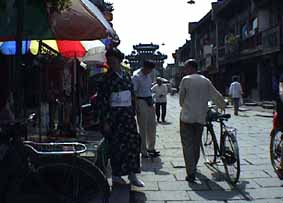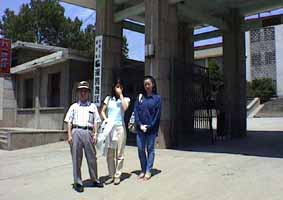
At Antique Market
|
The exhibition was a great success. After the event, we toured the city at notable sights, including the antique market. Maiko Dancer, in her kimono and Japanese hair style, was an instant spectacle wherever she went. The daytime temperature rose to 35℃ and was extremely hot. According to what we saw, there was a significant different in income among the people, resulting from the reform and liberal policy of the central government. We understand that people from the provinces are flooding to the large cities to seek for work opportunities to the point special job-placement businesses are now available. The average monthlyincome of the locals range from 1,500 yuan (21,000 yen/Jp) to 3,000 yuan (42,000 yen/Jp), where that of a migrant worker is between 15 yuan (210 yen/Jp) and 30 yuan (420 yen/Jp), according to statistics.
|
|
After visiting the Terra-cotta Soldiers and Horses of First Emperor of Qin Dyn asty, in the suburbs of Xi'an, we took lunch at a restaurant run by the People's Liberation Army. Yes, we are now in the capitalistic age when the dauntless People's Liberation Army of China is also running restaurants. The manager of the restaurant dressed in military uniform came to our table to offer cigarettes. In China, without exception, the no-smoking movement is rampant throughout the country, with fewer places to smoke freely.
|

In front of the restaurant run by the Army.
|
China, mainland, is entirely indulged in the mood of festivity with the reversion of Hong Kong back to the motherland.Red lanterns and colorful decorations full of primary colorscan be seen everywhere. We are grateful that the exhibitionat Xi'an City closed with commendable success backed by such political mood. As for sightseeing, we mainly enjoyed visiting many museums, including the Museum of the Terra-cotta Soldiers, the Historical Museum of Shan xi Sheng, and the Balu-Army Memorial. In an essence, it can be said we rushed through the 4,000 years of Chinese history in one sprint. Being surrounded with so many historic figures, we even dreamed of playing a game of mah-jong with four players: Zhuge Liang, Shi Huangdi, Xi Taihou and Zhou Enlai.
On the occasion of the acknowledgment banquet, held on the final day, the Curators of the Museum of the Terra-cotta Soldiers and the Historical Museum of Shan xi Sheng commented that the "Japanese hairstyle" and "Japanese kimono" may resemble certain similarities with Chinese costumes of the Tangdynasty. It is fully understandable that there is a similarity between the two clothes-types of people in those ancient days of frequent cultural exchange which demonstrates an evidence of close relationship between the two countries, China and Japan. But, in terms of the "Tsumami-Kanzashi", we think it was uniquely founded in Japan, since we have never heard of, up to now, about such foreign-made ornament, even in China. So the "Tsumami-Kanzashi" must be a genuine Japanese handicraft.
Last, but not least, we must emphasize before returning home that there are only ten or so "Tsumami-Kanzashi" craftsmen even in Japan, and thus, transplantation of the skills abroad is another goal of this exhibition.
|

